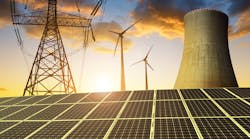Solar Drives U.S. Revenue Growth While Nuclear Sees a Global Bump
According to the Advanced Energy Now 2019 Market Report, advanced electricity generation is now the second largest advanced energy segment globally, having been displaced as the biggest by advanced transportation in 2017. At US$453 billion, advanced electricity generation was down slightly in 2018. Global revenue has been largely flat for the past two years, dropping roughly US$1 billion each year since 2016, but the total masks significant growth in solar and hydropower in 2017, nuclear power in 2018, and wind in both years.
In the United States, advanced electricity generation continues to be the second largest segment of the US$238 billion advanced energy market and is still growing strongly, up 8% in 2018, with revenue growth in wind and solar, while natural gas turbines held steady. Over the 2011 to 2018 period, the compound annual growth rate (CAGR) for advanced electricity generation revenue was -1% globally, while for the United States, revenue CAGR was 6%.
Advanced electricity generation in 2018 globally was boosted by investments in nuclear generation. Meanwhile, large hydropower projects in Africa continue to materialize despite long development cycles, and hydro buildout in Asia continues. Hydro led all generation categories with US$122.6 billion in revenue in 2018. Though now accounting for more than 1300 GW of installed capacity worldwide, hydro revenue declined 13% from 2017 to 2018. Solar photovoltaics (PV), at US$119.3 billion, declined 16% over 2017 after three consecutive years of revenue growth. This is primarily a function of declining prices, as 5.4 GW of solar PV was installed in 2018, up slightly from 5.3 GW in 2017.
Growth in wind revenue, the third largest generation category globally, has been somewhat cyclical, partly beacuse of fluctuations in the United States tied to the federal production tax credit (PTC). In 2018, wind revenue grew 2%, to US$95 billion globally. But there has been far greater year-to-year variability in nuclear and 2018 was a big up year. With an estimated US$60 billion in new orders, nuclear saw an increase of 208% after a 75% drop in 2017, following a record number of projects in 2016. Most of this growth occurred in Asia, led by China.
Gas turbine markets, including simple cycle and combined cycle varieties, declined 14% to US$28 billion in revenue in 2018, the lowest total for new orders in the eight-year period covered in this report.
In the United States, advanced electricity generation remained the second largest advanced energy segment, with US$59.6 billion in revenue in 2018. Growth in this segment over 2017 was 8%, slightly higher than a CAGR of 6% from 2011 to 2018.
For the seventh year, renewable energy accounted for the bulk of new utility-scale capacity, with nearly 11 GW added in 2018. At US$24.2 billion, solar PV remained the largest product category, showing an 8% increase in revenue even as costs declined. Including distributed as well as utility-scale, solar PV totaled 13.4 GW installed in 2018, up 14% from 11.8 GW in 2017. US$1.3 billion in solar thermal brings total solar revenue to a high of US$25.6 billion.
Wind remained the second largest subsegment with US$13.9 billion in revenue, up 23% after a down year in 2017. Looking over the past four years, U.S. wind revenue seems to be settling in at roughly US$14 billion annually under the five-year extension and phase-out of the federal PTC, in marked contrast to boom-and-bust cycles of previous years when fate of the PTC was uncertain.
U.S. revenue for gas turbines was US$15.1 billion, unchanged from 2017, but up 64% over 2016.
In the United States, continued coal retirements are driving greater use of existing natural gas facilities, new combined cycle generation, and renewable energy, with revenue flowing accordingly. Look for solar and wind to be paired with storage and begin to compete more directly with natural gas in many markets. Many states are increasing their renewable portfolio standards and considering similar policies to achieve 100% clean grids, with Hawaii and California already setting 100% renewable or clean energy commitments, while several newly elected governors have voiced intention to set similar goals.
U.S. wind and solar markets continue to be the largest sources of revenue in this segment, with solar PV slightly lower in 2017 following a massive 2016. In 2018, solar PV revenue rebounded to US$24.2 billion — nearly matching the 2016 peak of US$24.9 billion — driven primarily by utility-scale installations.
Solar PV’s steady growth benefits from extension of the federal investment tax credit (ITC) at the 30% level through 2019, after which it ratchets down for large installations (and phases out entirely for residential), along with falling prices which are projected to continue.
With a revenue of US$14 billion in three of the past four years, the wind industry seems to have lost its boom-and-bust character, at least through the extension and phase-out of the PTC this year.
The use of natural gas in power generation is expected to increase, although with potentially not as many new builds, as utilities find solar, wind, storage, and demand management competitive in meeting their capacity needs. This is evidenced by Northern Indiana Public Service Co.’s plan to replace all its remaining coal plants with these resources.
Utilities will be examining the locational value of distributed energy resources (DERs), particularly in states like California and New York. Navigant expects continued growth in DER deployment, with annual global capacity additions increasing four-fold by 2026. Energy storage integration will continue at both utility-scale and distributed renewables.
U.S. offshore wind markets are also ramping up, with large procurements announced in New York and New Jersey, following Massachusetts, Rhode Island, and Connecticut. Several thousand megawatts of offshore wind are expected to be developed along the eastern seaboard and results from Massachusetts suggest pricing will be lower than expected.


